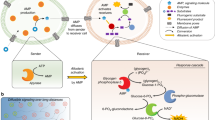Abstract
Multicellular organisms with complex tissue systems have evolved over a period from simple unicellular organisms. As opposed to unicellular organisms, which carry out most of their biological processes within a single cell, individual cells within a multicellular organization need to communicate with each other for the successful exchange of nutrients and signals, necessary for the maintenance of the organization. Organisms have evolved multiple strategies to achieve this goal, which include long-range interactions mediated by neural or endocrine mechanisms or short-range interactions that include direct physical or cell–cell contact. This is accomplished in a variety of ways, mostly by the formation of a series of pores, or communicating channels, which can facilitate cell–cell communication. In animal cell system, gap junctions between the cells form one such communication system. The fundamental function of two or more cells, coupled by gap junctions, is clearly to “communicate”. While humans communicate with other humans via words, body language, and touch, cells communicate with each other in a multicellular organism via chemical signals. The major physiological role of gap junctions is to synchronize metabolic or electronic signals between cells in a tissue. Cells have four basic functions, namely, (1) to proliferate, (2) to differentiate, (3) to apoptose or die by programmed cell death, and (4) to adaptively respond, if it is already terminally differentiated. In multicellular organism, a delicate coordination or orchestration of these four cellular functions must occur. Growth, differentiation, apoptosis, wound healing, and homeostatic control of differentiated functions must occur in a single space, and this is achieved by coupling the cells within a tissue/organ mainly through gap junctions.
You have full access to this open access chapter, Download chapter PDF
Similar content being viewed by others
Keywords
- Multicellular Organization
- Complex Tissue Systems
- Simple Unicellular Organisms
- Animal Cell Systems
- Delicate Coordination
These keywords were added by machine and not by the authors. This process is experimental and the keywords may be updated as the learning algorithm improves.
Multicellular organisms with complex tissue systems have evolved over a period from simple unicellular organisms. As opposed to unicellular organisms, which carry out most of their biological processes within a single cell, individual cells within a multicellular organization need to communicate with each other for the successful exchange of nutrients and signals, necessary for the maintenance of the organization. Organisms have evolved multiple strategies to achieve this goal, which include long-range interactions mediated by neural or endocrine mechanisms or short-range interactions that include direct physical or cell–cell contact. This is accomplished in a variety of ways, mostly by the formation of a series of pores, or communicating channels, which can facilitate cell–cell communication. In animal cell system, gap junctions between the cells form one such communication system. The fundamental function of two or more cells, coupled by gap junctions, is clearly to “communicate”. While humans communicate with other humans via words, body language, and touch, cells communicate with each other in a multicellular organism via chemical signals. The major physiological role of gap junctions is to synchronize metabolic or electronic signals between cells in a tissue. Cells have four basic functions, namely, (1) to proliferate, (2) to differentiate, (3) to apoptose or die by programmed cell death, and (4) to adaptively respond, if it is already terminally differentiated. In multicellular organism, a delicate coordination or orchestration of these four cellular functions must occur. Growth, differentiation, apoptosis, wound healing, and homeostatic control of differentiated functions must occur in a single space, and this is achieved by coupling the cells within a tissue/organ mainly through gap junctions.
Author information
Authors and Affiliations
Rights and permissions
Copyright information
© 2014 Springer India
About this chapter
Cite this chapter
Hussain, M.U. (2014). Introduction to Gap Junction. In: Connexins: The Gap Junction Proteins. SpringerBriefs in Biochemistry and Molecular Biology. Springer, New Delhi. https://doi.org/10.1007/978-81-322-1919-4_1
Download citation
DOI: https://doi.org/10.1007/978-81-322-1919-4_1
Published:
Publisher Name: Springer, New Delhi
Print ISBN: 978-81-322-1918-7
Online ISBN: 978-81-322-1919-4
eBook Packages: Biomedical and Life SciencesBiomedical and Life Sciences (R0)




